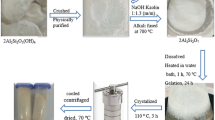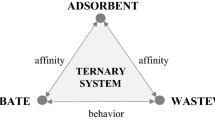Abstract
Reducing heavy metal concentrations to allowable levels in landfill leachate before discharge is an extremely important process to prevent environmental pollution. Iron oxide-coated gravel was used in order to remove Cd(II), Cu(II), Pb(II), Fe(III) and Al(III) simultaneously in high-strength synthetic leachate samples. Batch and column studies were performed to determine the kinetics and mechanism of adsorption process. The experimental data obtained from batch study satisfactorily fitted to the Freundlich model indicating surface heterogeneity and multilayer adsorption process. The data obtained from kinetic studies followed the pseudo-second-order kinetics indicating adsorption governed by chemisorption. The metal adsorption order observed in the batch study was Pb(II)(99.72%) ≈ Cu(II)(99.61%) ≈ Cd(II)(99.51%) ≈ Fe(III)(99.3%) > Al(III)(93.3%) at pH 7. Average metal removals in the fixed-bed column were found to be 96.5% for Cu(II), 94.8% for Pb(II), 90% for Cd(II), 84% for Fe(III) and 67% for Al(III). Iron oxide-coated gravel column adsorption capacity ranged from 0.56 to 66.82 mg/g. Recovery efficiency of adsorbed metals via desorption was between 5–97.75% in first cycle and 2–80.3% in second cycle.






Similar content being viewed by others
Abbreviations
- q e :
-
Amount of metal adsorbed at equilibrium (mg/g IOCG)
- C 0 :
-
Initial metal concentration (mg/L)
- V :
-
Volume of the leachate (L)
- M :
-
Mass of adsorbent (g)
- W :
-
Mass of IOCG (g)
- C e :
-
Equilibrium metal concentration of (mg/L)
- K L :
-
Langmuir isotherm constant
- q m :
-
Max. amount of metal adsorbed per IOCG (mg/g IOCG)
- k th :
-
Thomas rate constant (mL/min mg)
- q 0 :
-
Column adsorption capacity (mg/g)
- C t :
-
Metal concentration at time t (mg/L)
- Q :
-
Filtration flow rate (mL/min)
- t :
-
Filtration time (min)
- h :
-
Initial rate constant
- k 2 :
-
Overall rate constant
- K f :
-
Freundlich isotherm constant
- n :
-
Adsorption intensity
References
Abdullah AM (2014) Aluminum pollution removal from water using a natural zeolite. J Pollut Eff Control 2:120. https://doi.org/10.4172/2375-4397.1000120
Aboul-Magd A-AS, Al-Husain SA-R, Al-Zahrani SA (2016) Batch adsorptive removal of Fe(III), Cu(II) and Zn(II) ions in aqueous and aqueous organic–HCl media by Dowex HYRW2-Na Polisher resin as adsorbents. Arab J Chem 9(Supplement 1):S1–S8
Acheampong MA, Dapcic AD, Yeh D, Lens PNL (2013) Cyclic sorption and desorption of Cu(II) onto coconut shell and iron oxide coated sand. Sep Sci Technol 48:2786–2794
Ahmedzeki NS (2013) Adsorption filtration technology using iron-coated sand for the removal of lead and cadmium ions from aquatic solutions. Desalin Water Treat 51:5559–5565
Ajima MNO, Nnodi PC, Ogo OA, Adaka GS, Osuigwe DI, Njoku DC (2015) Bioaccumulation of heavy metals in Mbaa River and the impact on aquatic ecosystem. Environ Monit Assess 187:768
Allandin O, Wartel M, Recourt P, Revel B, Ouddane B, Billon G, Mabingui J, Boughriet A (2014) Adsorption capacity of iron oxyhydroxide-coated brick for cationic metals and nature of ion-surface interactions. Appl Clay Sci 90:141–149
Aly Z, Graulet A, Scales N, Hanley T (2014) Removal of aluminium from aqueous solutions using PAN-based adsorbents: characterisation, kinetics, equilibrium and thermodynamic studies. Environ Sci Pollut Res 21:3972–3986
Amin MA, Refat MS (2013) Study of complex formation in Al(III)—gluconic acid system and the influence of UV light on the dissolution and passive behavior of Al. Arab J Chem 6:165–172
Aydin H, Buluta Y, Yerlikaya C (2008) Removal of copper (II) from aqueous solution by adsorption onto low-cost adsorbents. J Environ Manag 87:37–45
Boujelben N, Bouzid J, Elouear Z (2009) Adsorption of nickel and copper onto natural iron oxide-coated sand from aqueous solutions: study in single and binary systems. J Hazard Mater 163:376–382
Buamah R, Petrusevski B, Schippers JC (2008) Adsorptive removal of manganese(II) from the aqueous phase using iron oxide coated sand. J Water Supply Res Technol Aqua 57:1–11
Chaudhry SA, Khan TA, Ali I (2016) Adsorptive removal of Pb(II) and Zn(II) from water onto manganese oxide-coated sand: isotherm, thermodynamic and kinetic studies. Egypt J Basic Appl Sci 3:287–300
Choksi PM, Joshi VY (2007) Adsorption kinetic study for the removal of nickel (II) and aluminum (III) from an aqueous solution by natural adsorbents. Desalination 208:216–231
Christophi CA, Axe L (2000) Competition of Cd, Cu, and Pb adsorption on goethite. J Environ Eng Asce 126:66–74
Daso AP, Fatoki OS, Odendaal JP, Olujimi OO (2013) Polybrominated diphenyl ethers (PBDEs) and 2,2′,4,4′,5,5′-hexabromobiphenyl (BB-153) in landfill leachate in Cape Town, South Africa. Environ Monit Assess 185:431–439
Doula MK (2009) Simultaneous removal of Cu, Mn and Zn from drinking water with the use of clinoptilolite and its Fe-modified form. Water Res 43:3659–3672
Figoli A, Hoinkis J, Bundschuh J (2015) Membrane Technologies for water treatment: removal of toxic trace elements with emphasis on arsenic, fluoride and uranium. Taylor & Francis, Milton Park
Han R, Zou L, Zhao X, Xu Y, Xu F, Li Y, Wang Y (2009) Characterization and properties of iron oxide-coated zeolite as adsorbent for removal of copper(II) from solution in fixed bed column. Chem Eng J 149:123–131
Haynes WM (2014) CRC handbook of chemistry and physics. CRC Press, Boca Raton
Haynes RJ (2015) Use of industrial wastes as media in constructed wetlands and filter beds-prospects for removal of phosphate and metals from wastewater streams. Crit Rev Environ Sci Technol 45:1041–1103
Idris SA, Alotaibi KM, Peshkur TA, Anderson P, Morris M, Gibson LT (2013) Adsorption kinetic study: effect of adsorbent pore size distribution on the rate of Cr(VI) uptake. Microporous Mesoporous Mater 165:99–105
Jeppu GP, Clement TP (2012) A modified Langmuir-Freundlich isotherm model for simulating pH-dependent adsorption effects. J Contam Hydrol 129:46–53
Johnson DB, Kanao T, Hedrich S (2012) Redox transformations of iron at extremely low pH: fundamental and applied aspects. Front Microbiol 3:96
Kan C-C, Aganon MC, Futalan CM, Dalida MLP (2013) Adsorption of Mn2+ from aqueous solution using Fe and Mn oxide-coated sand. J Environ Sci China 25:1483–1491
Kundu S, Gupta AK (2007) Adsorption characteristics of As(III) from aqueous solution on iron oxide coated cement (IOCC). J Hazard Mater 142:97–104
Lee S-M, Laldawngliana C, Tiwari D (2012) Iron oxide nano-particles-immobilized-sand material in the treatment of Cu(II), Cd(II) and Pb(II) contaminated waste waters. Chem Eng J 195:103–111
Lins C, Alves MCM, Campos JC, Silva FMS, Juca JFT, Lins EAM (2015) Removal of ammonia nitrogen from leachate of Muribeca municipal solid waste landfill, Pernambuco, Brazil, using natural zeolite as part of a biochemical system. J Environ Sci Health Part A Toxic/Hazard Subst Environ Eng 50:980–988
Mahmoud MR, Lazaridis NK (2015) Simultaneous removal of nickel(II) and chromium(VI) from aqueous solutions and simulated wastewaters by foam separation. Sep Sci Technol 50:1421–1432
McBride M (1994) Environmental soil chemistry. Oxford University Press, New York
Moghadam MR, Nasirizadeh N, Dashti Z, Babanezhad E (2013) Removal of Fe(II) from aqueous solution using pomegranate peel carbon: equilibrium and kinetic studies. Int J Ind Chem 4:19
Mojiri A, Aziz HA, Zaman NQ, Aziz SQ, Zahed MA (2016) Metals removal from municipal landfill leachate and wastewater using adsorbents combined with biological method. Desalin Water Treat 57:2819–2833
Nguyen TV, Vigneswaran S, Ngo HH, Kandasamy J (2010) Arsenic removal by iron oxide coated sponge: experimental performance and mathematical models. J Hazard Mater 182:723–729
Nightingale E Jr (1959) Phenomenological theory of ion solvation. Effective radii of hydrated ions. J Phys Chem 63:1381–1387
Norris MJ, Pulford ID, Haynes H, Dorea CC, Phoenix VR (2013) Treatment of heavy metals by iron oxide coated and natural gravel media in sustainable urban drainage systems. Water Sci Technol 68:674–680
Park SJ, Lee CG, Kim JH, Kim SB, Chang YY, Yang JK (2015) Bimetallic oxide-coated sand filter for simultaneous removal of bacteria, Fe(II), and Mn(II) in small- and pilot-scale column experiments. Desalin Water Treat 54:3380–3391
Persson I (2010) Hydrated metal ions in aqueous solution: how regular are their structures? Pure Appl Chem 82:1901–1917
Qian G et al (2014) Removal of Fe3+ from aqueous solution by natural apatite. J Surf Eng Mater Adv Technol 4(1):14
Roney N (2005) Toxicological profile for zinc. Agency for Toxic Substances and Disease Registry
Schott H (1977) Relationship between zero point of charge and solubility product for hydroxides of polyvalent cations. J Pharm Sci 66:1548–1550
Singh D (2011) Basic concepts of inorganic chemistry. Pearson Education India, Bengaluru
Sivrikaya S, Albayrak S, Imamoglu M, Gundogdu A, Duran C, Yildiz H (2012) Dehydrated hazelnut husk carbon: a novel sorbent for removal of Ni(II) ions from aqueous solution. Desalin Water Treat 50:2–13
Sizirici B, Tansel B (2015) Parametric fate and transport profiling for selective groundwater monitoring at closed landfills: a case study. Waste Manag 38:263–270
Sizirici B, Yildiz I (2017) Adsorption capacity of iron oxide-coated gravel for landfill leachate: simultaneous study. Int J Environ Sci Technol 14:1027–1036
Sounthararajah DP, Loganathan P, Kandasamy J, Vigneswaran S (2015) Adsorptive removal of heavy metals from water using sodium titanate nanofibres loaded onto GAC in fixed-bed columns. J Hazard Mater 287:306–316
Srivastava VC, Mall ID, Mishra IM (2009) Competitive adsorption of cadmium(II) and nickel(II) metal ions from aqueous solution onto rice husk ash. Chem Eng Process 48:370–379
Sud D, Mahajan G, Kaur MP (2008) Agricultural waste material as potential adsorbent for sequestering heavy metal ions from aqueous solutions—a review. Biores Technol 99:6017–6027
Thuy Chung N, Loganathan P, Tien Vinh N, Vigneswaran S, Kandasamy J, Naidu R (2015) Simultaneous adsorption of Cd, Cr, Cu, Pb, and Zn by an iron-coated Australian zeolite in batch and fixed-bed column studies. Chem Eng J 270:393–404
Tiwari D, Laldanwngliana C, Choi C-H, Lee SM (2011) Manganese-modified natural sand in the remediation of aquatic environment contaminated with heavy metal toxic ions. Chem Eng J 171:958–966
Tiwari D, Lalhmunsiama, Lee S-M (2015) Iron-impregnated activated carbons precursor to rice hulls and areca nut waste in the remediation of Cu(II) and Pb(II) contaminated waters: a physico-chemical studies. Desalin Water Treat 53:1591–1605
Unob F, Wongsiri B, Phaeon N, Puanngam M, Shiowatana J (2007) Reuse of waste silica as adsorbent for metal removal by iron oxide modification. J Hazard Mater 142:455–462
WHO (2004) Guidelines for drinking-water quality: recommendations. World Health Organization, Geneva
Yang J-S, Kwon MJ, Park Y-T, Choi J (2015) Adsorption of arsenic from aqueous solutions by iron oxide coated sand fabricated with acid mine drainage. Sep Sci Technol 50:267–275
Yargic AS, Sahin RZY, Ozbay N, Onal E (2015) Assessment of toxic copper(II) biosorption from aqueous solution by chemically-treated tomato waste. J Clean Prod 88:152–159
Zamil SS, Ahmad S, Choi MH, Park JY, Yoon SC (2009) Correlating metal ionic characteristics with biosorption capacity of Staphylococcus saprophyticus BMSZ711 using QICAR model. Biores Technol 100:1895–1902
Zulfadhly Z, Mashitah MD, Bhatia S (2001) Heavy metals removal in fixed-bed column by the macro fungus Pycnoporus sanguineus. Environ Pollut 112:463–470
Acknowledgements
This study was funded by the Khalifa University, KUIRF L1 210045 Grant. The authors are acknowledged the help of Dr. Maguy Abi Joude for SEM analysis, Dr. Liang Li for XRD analysis and Dr. Kyriaki Polychronopoulou for BET analysis.
Author information
Authors and Affiliations
Corresponding author
Additional information
Editorial responsibility: M. Abbaspour.
Rights and permissions
About this article
Cite this article
Sizirici, B., Yildiz, I. Simultaneous adsorption of divalent and trivalent metal cations by iron oxide-coated gravel. Int. J. Environ. Sci. Technol. 15, 2647–2656 (2018). https://doi.org/10.1007/s13762-018-1644-8
Received:
Revised:
Accepted:
Published:
Issue Date:
DOI: https://doi.org/10.1007/s13762-018-1644-8




